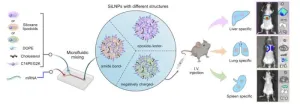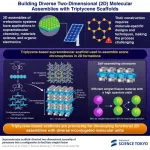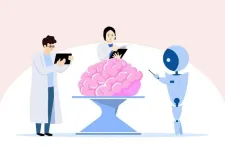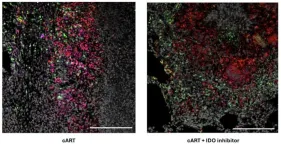(Press-News.org) While divisive social media posts get more traction in countries such as the US, a new study shows that celebrating national unity is the way to go viral in Ukraine.
“Ingroup solidarity” statements got far more likes and shares than hostile posts about Russians – a trend that only grew stronger in the wake of the invasion.
The first major study of social media behaviour during wartime has found that posts celebrating national and cultural unity in a country under attack receive significantly more online engagement than derogatory posts about the aggressors.
University of Cambridge psychologists analysed a total of 1.6 million posts on Facebook and Twitter (now X) from Ukrainian news outlets in the seven months prior to February 2022, when Russian forces invaded, and the six months that followed.
Once the attempted invasion had begun, posts classified as expressing Ukrainian “ingroup solidarity” were associated with 92% more engagement on Facebook, and 68% more on Twitter, than similar posts had achieved prior to Russia’s full-scale attack.
While posts expressing “outgroup hostility” towards Russia only received an extra 1% engagement on Facebook after the invasion, with no significant difference on Twitter.
“Pro-Ukrainian sentiment, phrases such as Glory to Ukraine and posts about Ukrainian military heroism, gained huge amounts of likes and shares, yet hostile posts aimed at Russia barely registered,” said Yara Kyrychenko, from Cambridge’s Social Decision-Making Lab (SDML) in its Department of Psychology.
“The vast majority of research on social media uses US data, where divisive posts often go viral, prompting some scholars to suggest that these platforms drive polarisation. In Ukraine, a country under siege, we find the reverse,” said Kyrychenko, lead author of the study published today in Nature Communications.
“Emotions that appeal to ingroup identity can empower people and boost morale. These emotions may be more contagious, and prompt greater engagement, during a time of active threat – when the motivation to behave beneficially for one’s ingroup is heightened.”
Previous research from the same Cambridge lab found that going viral on US social media is driven by hostility: posts that mock and criticise the opposing sides of ideological divides are far more likely to get engagement and reach larger audiences.
The new study initially used the same techniques, finding that – prior to the invasion –social media posts from pro-Ukrainian as well as pro-Russian news sources that contained keywords of the ‘outgroup’ – opposing politicians, placenames, and so on – it did indeed generate more traction than posts containing ‘ingroup’ keywords.*
However, researchers then trained a large language model (LLM) – a form of language-processing AI, similar to ChatGPT – to better categorise sentiment and the motivation behind the post, rather than simply relying on keywords, and used this to analyse Facebook and Twitter posts of Ukrainian news outlets before and after the invasion.**
This deeper dive revealed a consistently strong engagement rate for solidarity posting – higher than for ‘outgroup hostility’ – in the lead up to Russia’s attack, which leaps even further after the invasion, while interactions with derisive posts about Russia flatline.
Lastly, a separate dataset of 149,000 post-invasion Tweets that had been geo-located to Ukraine was fed into a similar LLM, to test this effect on social media posts from the Ukrainian population, rather than only news sources.***
Tweets – now X posts – from the Ukrainian public containing messages of “ingroup solidarity” championing Ukraine were likely to get 14% more engagement, while those expressing antagonism to Russians were likely to gain only a 7% increase.****
“Social media platforms allow expressions of the national struggle that would otherwise have been private to reach millions,” said Kyrychenko.
“These moments echo solidarity and resistance from a first-person account, which can make them more powerful than traditional media rooted in impersonal reporting.”
Researchers acknowledge these trends may result from algorithms used by social media companies, but say the fact that similar effects were detected on two separate platforms, and with posts from both Ukraine’s news sources and its citizenry, suggests much of this information-sharing dynamic is driven by people.
“The Kremlin has long tried to sow division in Ukraine, but fails to understand that the Euromaidan revolution and Russia’s attempted invasion have only spurred Ukrainian identity towards national unity,” said Dr Jon Roozenbeek, study senior author from Cambridge’s SDML as well as King’s College London.
“We can trace through social media posts this fortification of Ukrainian group identity in the face of extreme Russian aggression,” said Roozenbeek, who published the book Propaganda and Ideology in the Russian–Ukrainian War earlier this year.
Kyrychenko, a Cambridge Gates Scholar born and raised in Kyiv, recalls the critical role Facebook and Twitter played in the Euromaidan protests in 2014, some of which she participated in as a teenager, and her surprise at the attitude towards social media she encountered in the US after moving there to study in 2018, during the Trump presidency.
“By the time I arrived in the US, social media was seen as toxic and divisive, whereas my experience of these platforms in Ukraine had been as a force for positive political unity in the fight for democracy,” said Kyrychenko.
While Kyrychenko points out that hate speech and conspiracy theories still thrive online in Ukraine, she argues that the solidarity fostered on social media reflects some of the early promise these platforms held for uniting people against tyranny.
“The Ukrainian experience reminds us that social media can be used for good, pro-social causes, even in the direst of situations.”
NOTES:
* Facebook and Twitter were banned in Russia following the invasion. As such, this initial element of the study was the only one to feature Russian social media posts.
** The team manually labelled 1600 Ukrainian social media posts as either “ingroup solidarity” or “outgroup hostility” based on whether they praised Ukraine and promoted national unity or attacked Russia as immoral warmongers, and fed these into the LLM to train it to read and categorise Ukrainian social media posts. The researchers also provided the LLM guideline definitions for “ingroup solidarity” and “outgroup hostility”.
*** The researchers only used pro-Ukrainian Tweets: posts that were supportive of Ukraine, whether through attacking Russia or championing Ukraine.
**** For example, if the LLM labelled a post as ‘ingroup solidarity’, it was likely to get 14% more engagement than if it was not labelled as ‘ingroup solidarity’, controlling for other variables such as: if the post has media or a URL, if it mentioned the ingroup, the outgroup, the number of ‘positive’ words, and so on.
Examples of social media posts that were part of the study’s dataset:
Ingroup solidarity:
"Thanks to the KALUSH ORCHESTRA band for their support! Glory to Ukraine! ????????" got 4434 retweets.
"Our flag will fly over all of Ukraine, said General Valery Zaluzhnyi." got 5577 favorites and 767 retweets.
"Ukrainian soldiers congratulate students with September 1 and remembers their first bells ????????" ... got 92381 shares and 482896 likes on Facebook.
"In a Polish church, they decided to sing the song "Oh, there's a red viburnum in the meadow" right during the service! ???????? ❤️????????" ... got 34897 shares and 68847 likes on Facebook.
A further description from lead author Yara Kyrychenko of an example of Ukrainian ‘ingroup solidarity’ social media content:
“On New Year’s Eve 2022, a family in the then recently de-occupied Ukrainian city of Kherson watched Volodymyr Zelensky’s presidential address over WhatsApp with their relatives in the still-occupied territories.
“A video of the entire family crying – as Zelensky states Ukraine will liberate and rebuild – quickly went viral across platforms. It captured something so powerful and deeply emotional that watching it makes many cry, even months later.
“The sense of unity despite barriers, the tender cherishing of the national tradition, and the human connection—all distilled into one TikTok. Posts like these evoke similar feelings of solidarity in countless Ukrainians, even though each has seen a different face of the war.”
Outgroup Hostility:
"Boris Johnson: negotiating with Putin is like negotiating with a crocodile" got 425 retweets and 4957 favorites.
"It hurts to understand that these bastards shoot absolutely everything. It doesn't matter if the military is there or not. Hospitals, schools...." got 21728 Shares and 25125 Likes.
"❗️Russians don't want to fight for Putin. The story of a soldier captured in Kharkov. "Bastards! I hate them! They are making propaganda!"" ... got 65409 shares and 79735 Likes. END
Solidarity drives online virality in a nation under attack, study of Ukrainian social media reveals
2024-10-01
ELSE PRESS RELEASES FROM THIS DATE:
Research heralds new era for genetics
2024-10-01
UNDER STRICT EMBARGO UNTIL 10AM (UK TIME) ON TUESDAY 1 OCTOBER 2024.
Peer reviewed | Observational study | People
Research led by scientists at Queen Mary University of London is heralding in a new era for genetic sequencing and testing.
In the largest study of its kind to date, published today in Nature Medicine, an international group of researchers led by Queen Mary used new bioinformatics techniques to scan the genetic profiles of 80,000 people to understand the frequency of specific expansions of short repetitive DNA sequences in the general population.
These expansions are the most common cause of inherited neurological ...
Deep brain stimulation instantly improves arm and hand function post-brain injury
2024-10-01
Deep brain stimulation may provide immediate improvement in arm and hand strength and function weakened by traumatic brain injury or stroke, University of Pittsburgh School of Medicine researchers report today in Nature Communications.
Encouraging results from extensive tests in monkeys and humans open a path for a new clinical application of an already widely used brain stimulation technology and offer insights into neural mechanisms underlying movement deficits caused by brain injury.
“Arm and hand paralysis significantly impacts the quality ...
Siloxane nanoparticles unlock precise organ targeting for mRNA therapy
2024-10-01
Penn Engineers have discovered a novel means of directing lipid nanoparticles (LNPs), the revolutionary molecules that delivered the COVID-19 vaccines, to target specific tissues, presaging a new era in personalized medicine and gene therapy.
While past research — including at Penn Engineering — has screened “libraries” of LNPs to find specific variants that target organs like the lungs, this approach is akin to trial and error. “We’ve never understood how the structure of one key component of the LNP, ...
Building better solar cells: assembly of 2D molecular structures with triptycene scaffold
2024-10-01
Research in the field of material science and electronics relies on the innovative arrangement of molecules or atoms to develop materials with unique properties not found in conventional materials. Two-dimensional (2D) assemblies of π-electronic systems, arranged in thin layers, are becoming increasingly important in the fields of materials science and organic electronics. Their unique arrangement allows for specific electronic and physical properties, making them ideal for applications like solar cells, and flexible displays. However, creating such assemblies is challenging because it often requires special designs and techniques for each ...
Maybe we shouldn’t even call low-grade prostate cancer “cancer”
2024-10-01
A new paper in the Journal of the National Cancer Institute, published by Oxford University Press, indicates that patients may benefit if doctors stop calling certain early-stage changes to the prostate “cancer” at all.
Prostate cancer is the second leading cause of cancer death worldwide in men, but far more patients are diagnosed than die of the disease. In 2022, there were nearly 1.5 million cases of prostate cancer, but only 400,000 deaths. Low-grade prostate cancer, commonly known as GG1 among physicians, virtually never metastasizes or causes symptoms. Some medical researchers have wondered recently if it would be a benefit ...
‘Cheeky’ discovery allows scientists to estimate your risk of dying using cells found in the mouth
2024-10-01
We don’t all age at the same rate. But while some supercentenarians may age exceptionally slowly due to winning the genetics jackpot, a plethora of behavioral and lifestyle factors are known to speed up aging, including stress, poor sleep, poor nutrition, smoking, and alcohol. Since such environmental effects get imprinted on our genome in the form of epigenetic marks, it is possible to quantify molecular aging by characterizing the epigenome at prognostic genomic sites.
Over the past decade, scientists have developed several such ‘epigenetic clocks’, calibrated against chronological age and various lifestyle factors across large ...
ChatGPT shows human-level assessment of brain tumor MRI reports
2024-10-01
As artificial intelligence advances, its uses and capabilities in real-world applications continue to reach new heights that may even surpass human expertise. In the field of radiology, where a correct diagnosis is crucial to ensure proper patient care, large language models, such as ChatGPT, could improve accuracy or at least offer a good second opinion.
To test its potential, graduate student Yasuhito Mitsuyama and Associate Professor Daiju Ueda’s team at Osaka Metropolitan University’s Graduate ...
Promising TB therapy safe for patients with HIV
2024-10-01
SAN ANTONIO (October 1, 2024) – A therapy showing promise to help control tuberculosis (TB) does not interfere with combined antiretroviral therapy (cART), according to research by Texas Biomedical Research Institute (Texas Biomed).
“This is an important hurdle that this host-directed therapy had to clear in order to help patients battling both HIV and TB,” said Texas Biomed Professor Smriti Mehra, Ph.D., who led the study recently published in the peer-reviewed journal JCI Insight.
TB is responsible for more than 1.3 million deaths worldwide every year. Dr. Mehra ...
American Academy of Pediatrics examines the impact of school expulsion and recommends ways to create supportive learning environments for all students
2024-10-01
Media Contacts:
Alex Hulvalchick, 630-626-6282
Lisa Robinson, 630-626-6084, lrobinson@aap.org
American Academy of Pediatrics Examines the Impact of School Expulsion and Recommends Ways to Create Supportive Learning Environments for All Students
Updated policy statement on school suspension to be released during the AAP 2024 National Conference & Exhibition in Orlando.
ORLANDO, Fla.--Suspending or expelling a student is one of the most severe punishments a school can impose on a student – and it can have lifelong, devastating consequences. ...
Most pregnant people got vaccinated for COVID-19 in 2022
2024-10-01
A study of more than 28,000 pregnancies from 2022 has found that the majority of pregnant people received the COVID-19 vaccine during its initial release.
The study, co-led by McMaster University and the University of British Columbia, used data from ICES, an independent, not-for-profit research institute, to provide insight into vaccination rates among one of the groups most vulnerable to health complications caused by COVID-19.
The research, published in the Canadian Medical Association Journal (CMAJ) ...




